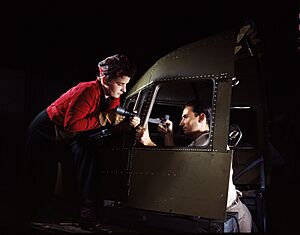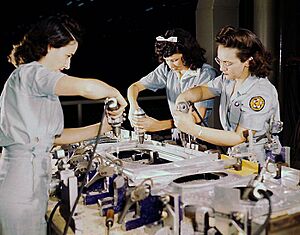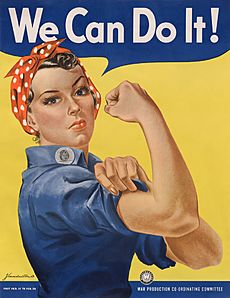Rosie the Riveter facts for kids
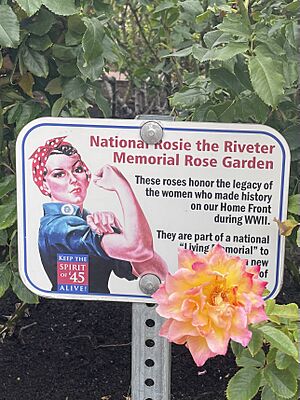
Rosie the Riveter is a famous cultural icon in the United States. She stands for the many women who worked in factories and shipyards during World War II. These women often made munitions (war supplies) and other important items. Many of them took on jobs that men used to do, as the men had joined the military.
Rosie is widely known from the "We Can Do It!" poster. She became a symbol of American feminism (the movement for women's rights) and women's strength. Similar images of women working during the war appeared in other countries too, like Britain and Australia. The idea of Rosie the Riveter started with a song written in 1942 by Redd Evans and John Jacob Loeb. Pictures of women workers were everywhere in the media, including government posters and advertisements. These were used to encourage women to help with the war effort in factories. A Hollywood movie called Rosie the Riveter was even made in 1944.
Contents
History of Women in the Workforce
Women Working During Wartime

World War I and World War II were "total wars." This meant that governments needed everyone, including civilians, to help win. Millions of women were encouraged to work in factories and take over jobs that men had done before. During World War I, women across the United States took on many new roles. World War II was similar because so many men joined the military. This caused a shortage of workers, and women stepped in to fill these important jobs.
Nearly 19 million women had jobs during World War II. Many of these women were already working in lower-paying jobs. Others were returning to work after losing their jobs during the Great Depression. About three million new women workers joined the workforce during the war.
Women answered the country's call for help. They took on jobs that were usually done by men. They learned to operate heavy machinery. They worked in lumber and steel mills. They also did physical labor like unloading freight, building airships, and making munitions. For example, Pan American Airways hired 40 women to repair and maintain aircraft at LaGuardia Airport.
Many women found that these jobs gave them a new sense of freedom. It changed what they thought women could do. However, when men returned from the war, the government encouraged women to go back to their homes.
Even though most women took on male-dominated jobs during World War II, they were expected to return to housework once the men came home. Government campaigns often spoke only to housewives. One advertisement asked women: "Can you use an electric mixer? If so, you can learn to operate a drill." Propaganda was also aimed at husbands, as some did not support their wives working.
Many women who took jobs during World War II were mothers. These women often worked together to raise their families. They shared chores like cooking, cleaning, and washing clothes. Many who had young children shared apartments or houses to save time and money. If both parents worked, they would work different shifts to take turns caring for their children. People wondered if women should keep working or stay home as full-time mothers.
Over six million women got war jobs. African American, Hispanic, White, and Asian women worked side by side. Vi Kirstine Vrooman, in her book A Mouthful of Rivets, wrote about becoming a riveter. She built B-17 airplanes on an assembly line. She said, "The biggest thrill—I can't tell you—was when the B-17s rolled off the assembly line. You can't believe the feeling we had. We did it!" Once women took on these challenges, they continued to make progress toward equal rights.
In 1944, when the Allied Forces seemed sure to win, government messages changed. They started urging women to return to working in the home. After the war, many women went back to traditional jobs like office work. They often preferred not to return to lower-paying fields. However, some women did continue working in factories. The total percentage of women working dropped from 36% to 28% by 1947.
The Song "Rosie the Riveter"
Quick facts for kids "Rosie the Riveter" |
|
|---|---|
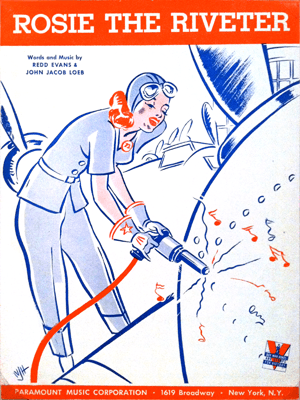
Cover of the music for the 1942 song
|
|
| Song by Kay Kyser | |
| Published | 1942 |
| Songwriter(s) | Redd Evans, John Jacob Loeb |
The name "Rosie the Riveter" was first used in 1942 in a song by Redd Evans and John Jacob Loeb. Many artists recorded the song, including the popular big band leader Kay Kyser. It became a national hit. The song describes "Rosie" as a hardworking factory employee. She earned a "Production E" award for helping the American war effort.
People have debated who the "real" Rosie the Riveter was. Some possible candidates include:
- Rosina "Rosie" Bonavita, who worked for Convair in San Diego, California.
- Rosalind P. Walter, who worked building fighter planes at night.
- Adeline Rose O'Malley, a riveter at Boeing's Wichita plant.
- Rose Will Monroe, a riveter at the Willow Run Aircraft Factory in Ypsilanti, Michigan. She helped build B-24 bombers. The song "Rosie the Riveter" was already popular when Monroe was chosen to appear in a film about the war effort at home. "Rosie" became a very well-known symbol of that time. The films and posters she appeared in encouraged women to work for the war. Later, at age 50, Monroe got her pilot's license. She died in 1997 at age 77.
In Canada, in 1941, Veronica Foster became "Ronnie, the Bren Gun Girl." She was Canada's symbol for women in the war effort.
A 1944 drama film, Rosie the Riveter, was also inspired by the Rosie theme.
Impact of Rosie the Riveter
During World War II
"Rosie the Riveter" inspired a big social change. The number of American women working grew from 12 million to 20 million by 1944. This was a 57% increase from 1940. By 1944, 4.1 million unmarried women worked in defense industries, compared to 1.7 million unmarried men.
The image of "Rosie the Riveter" showed women doing industrial jobs like welding and riveting. However, most working women filled other jobs in every part of the economy. What was important was that these women proved to themselves and the country that they could do a "man's job" and do it well.
In 1942, employers quickly changed their minds about what jobs women could do. The number of jobs considered "acceptable" for women went from 29% to 85% in just six months. African American women were greatly affected by the need for workers. It is said that white and Black people working together during this time helped break down social barriers and encouraged respect for diversity.
After the War
Women quickly responded to Rosie the Riveter. She convinced them it was their duty to work for their country. Some people believe she opened up the workforce for women forever. Others disagree, saying that many women were laid off after the war. Their jobs were given to men returning from the military. These critics say that few women kept their wartime jobs. Instead, they went back to being housewives or took jobs like office work.
Some historians see World War II as a major turning point for women. They eagerly supported the war effort. Other historians say the changes were only temporary. They point out that right after the war, women were expected to return to their traditional roles as wives and mothers. A third group believes that the changes from the war were very important. They laid the groundwork for the women's movement we see today. Leila J. Rupp, who studied World War II, wrote that "For the first time, the working woman dominated the public image. Women were riveting housewives in slacks, not mother, domestic beings, or civilizers."
After the war, as the country became peaceful again, women were quickly laid off from their factory jobs. The "Rosies" and the generations after them knew that working in factories was possible for women. However, women did not re-enter the job market in such large numbers again until the 1970s. By then, factory jobs were already decreasing across the country.
Elinor Otto, known as the "Last Rosie the Riveter," built airplanes for 50 years. She retired at age 95.
Recognizing Rosie's Legacy
The Life and Times of Rosie the Riveter is a 1980 documentary film. It tells the story of women taking on "men's work" during WWII. Rosies of the North is a 1999 Canadian documentary. It is about Canadian "Rosies" who built fighter and bomber aircraft.
John Crowley's 2009 novel Four Freedoms talks about wartime industries. It also looks at the real working conditions of many female factory workers. "Rosie the Riveter" is often mentioned in the book.
On October 14, 2000, the Rosie the Riveter/World War II Home Front National Historical Park opened in Richmond, California. This was the site of four Kaiser Shipyards. Thousands of "Rosies" from all over the country worked there. (Though ships at Kaiser yards were welded, not riveted). Over 200 former Rosies attended the opening ceremony.
In 2014, Phyllis Gould, one of the original Rosie the Riveters, visited President Barack Obama. She supported a National Rosie the Riveter Day. The United States Senate approved this day on March 21, 2017. She also pushed for a Gold Medal for Rosies, which will be given starting in 2022.
Also in 2014, a program called Thanks! Plain and Simple was started. It encourages cities to create projects where "Rosies" can work with younger generations. This helps teach young people about women's roles in World War II. It also helps "Rosies," many of whom are older and isolated, get involved in community projects.
The Metropolitan Riveters is a women's hockey team. Their name and logo are inspired by Rosie the Riveter.
The Rose City Riveters is the fan club for the Portland Thorns Football Club. This is a women's soccer team in Portland, Oregon. They are inspired by the 30,000 women who worked in the Portland shipyards during World War II.
Images for kids
The "We Can Do It!" Poster
In 1942, artist J. Howard Miller was hired by Westinghouse Company. He created posters for the war effort. One of these posters became the famous "We Can Do It!" image. Later, this image was also called "Rosie the Riveter," but it wasn't given that name during the war. Miller likely based his poster on a photo of a young female war worker. This worker was widely, but incorrectly, thought to be Geraldine Hoff (later Doyle).
More recent evidence shows that the photo was actually of Naomi Parker Fraley. She worked at Alameda Naval Air Station in California. The "We Can Do It!" poster was only shown to Westinghouse employees in the Midwest for two weeks in February 1943. Then it disappeared for almost 40 years. During the war, the name "Rosie" was not linked to this image. The poster's goal was not to hire women workers. It was meant to motivate all workers at Westinghouse. It was only later, in the early 1980s, that the Miller poster was found again. It became famous, linked to feminism, and often mistakenly called "Rosie the Riveter."
Norman Rockwell's Saturday Evening Post Cover

Norman Rockwell's image of "Rosie the Riveter" became very popular. It was on the cover of The Saturday Evening Post on Memorial Day, May 29, 1943. Rockwell's drawing shows a strong woman taking a lunch break. She has a rivet gun on her lap. Under her foot is a copy of Adolf Hitler's book, Mein Kampf. Her lunch box says "Rosie." Viewers quickly knew this was "Rosie the Riveter" from the popular song.
Rockwell was a very famous illustrator at the time. He based Rosie's pose on Michelangelo's 1509 painting Prophet Isaiah from the Sistine Chapel ceiling. Rosie is holding a sandwich. Her blue overalls have many badges and buttons. These include a Red Cross blood donor button, a "V for Victory" button, and military service awards.
Rockwell's model was Mary Louise Doyle, a 19-year-old telephone operator from Vermont. She was not a riveter. Rockwell painted his "Rosie" as larger than his model. He later apologized to her for making her look like a "giant."
Mary explained that she was holding a sandwich while posing. The rivet gun she held was fake. She never saw Mein Kampf. She did have a white handkerchief in her pocket, just like in the picture. The Post cover was very popular. The magazine loaned it to the United States Department of the Treasury to help sell war bonds.
After the war, Rockwell's "Rosie" was seen less often. This was because Rockwell's family protected the copyright. In 2002, the original painting sold for nearly $5 million. In 2009, the Crystal Bridges Museum of American Art bought the painting for its collection.
In 1942, Doyle posed twice for Rockwell's photographer. She was paid $10 for her modeling work. In 1949, she married Robert J. Keefe and became Mary Doyle Keefe. She died on April 21, 2015, at age 92. In a 2014 interview, Keefe said she had no idea how famous the painting would become.
Images for kids
See also
 In Spanish: Rosie the Riveter para niños
In Spanish: Rosie the Riveter para niños
- Naomi Parker Fraley
- Australian Women's Land Army
- Canary girl – British women working in munitions
- G.I. Generation
- Ronnie the Bren Gun Girl – the earlier Canadian equivalent
- Ruby Loftus Screwing a Breech-ring, a 1943 painting showing a female British war worker
- United States home front during World War II
- Women in the World Wars
- Women in World War II
- American women in World War II
- Women in World War II
- Women in the United States labor force from 1945 to 1950
- Women in the workforce
- Woman's Land Army of America ("farmettes")
- Women's Land Army – British farm workers ("land girls")
- Work ethic
- Margaret Bourke-White




